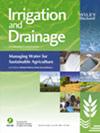Impact of the Timing of First Irrigation and Subsequent Irrigation Schedules on Direct-Seeded Furrow-Irrigated Basmati Rice: Crop Growth, Productivity, Water Balance and Profitability
Abstract
Addressing food security and water scarcity calls for the cultivation of rice with improved productivity while minimizing water use. To assess the impact of planting techniques and irrigation schedules on the grain yield and water productivity of direct-seeded basmati rice (DSBR), a 2-year field experiment was conducted. This study tested whether (1) broad beds (90:30 cm) would increase water productivity and yield compared with conventional beds (37.5:30 cm) and (2) delaying the first irrigation and optimizing schedules would improve water efficiency without reducing yield. A split-plot design was used with planting techniques (conventional and broad beds) and the timing of the first irrigation (7 and 14 DAS) in the main plots, whereas subsequent irrigation schedules (IW/ETc values of 1.50, 1.75 and 2.0) were tested in the subplots. The results revealed that increasing the bed width did not significantly impact yield. Delaying the first irrigation saved 59 mm (5%) of water and reduced deep drainage by 107 mm (9%) without affecting yield or actual ET. Subsequent irrigation scheduling at IW/ETc ratios of 1.75 and 2.0 increased the grain yield by 10%–15% compared with 1.50 IW/ETc. Nonetheless, an IW/ETc of 1.75 saved approximately 17% of the irrigation water compared with an IW/ETc of 2.0, reducing the cultivation cost by US$ 30.2–43.8 ha−1 while maintaining a similar grain yield.

 求助内容:
求助内容: 应助结果提醒方式:
应助结果提醒方式:


